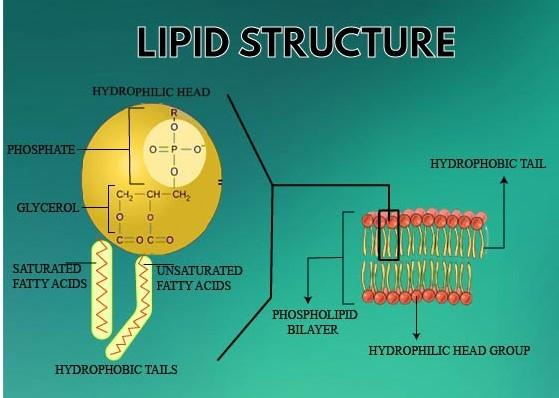
A lipid is a polymer made up of
(a) Modified glucose molecules
(b) Amino acids
(c) Nucleotides
(d) Fatty acids and glycerol
Answer
516.6k+ views
1 likes
Hint: In humans and other animals lipids are the main constituents of body fat, as well as vegetable fat. The primary feature all lipid molecules share is they don't dissolve in water.
Complete answer:
A lipid is a polymer composed of three fatty acid molecules and one glycerol molecule. Lipids produce a special polymer form which is considered to be a key component of cell membranes and hormones. Lipids help to store energy, provide cushion, protect tissues, separate the body, and form membranes of cells.
- Glucose molecules are the monomers that constitute the polysaccharides.
- Amino acids are the polypeptide chain or protein monomer. 20 amino acids make up the various protein types.
- Nucleotides are the nucleic acid monomers e.g. DNA and RNA.
Fatty acids are lipid monomers formed by a hydrocarbon chain with a carboxyl group attached at the end. This is the simplest form of polymer in lipids. A carboxyl group consists of a carbon atom that forms a double bond with a single atom of oxygen and a single bond with an atom of oxygen bound to another atom of carbon. These chains make up the saturated and unsaturated fats in animals and plants.
Glycerol is a simple alcohol composed of three atoms of oxygen and three atoms of carbon that bind eight times with hydrogen atoms. When each single- bonded oxygen molecule binds to a carbon that is part of a glycerol molecule, fatty acids form more complex lipid polymers called triglycerides, triacylglycerols, or triacylglycerides. Triglycerides, especially make up animal products.

So, the correct answer is, ‘Fatty acids and glycerol’.
Note: Lipids are substances that are water- insoluble and can be categorized as fats, phospholipids, waxes, and steroids. This makes lipids essential to building structures, such as cell membranes, that have to retain their shape when surrounded by liquid. Its tight molecular bonds make lipids ideal for long-term storage of energy. The insolubility of lipid molecules is given because they form with ester bonds, compounds formed from an alcohol and acid by removing a hydrogen atom in a water molecule.
Complete answer:
A lipid is a polymer composed of three fatty acid molecules and one glycerol molecule. Lipids produce a special polymer form which is considered to be a key component of cell membranes and hormones. Lipids help to store energy, provide cushion, protect tissues, separate the body, and form membranes of cells.
- Glucose molecules are the monomers that constitute the polysaccharides.
- Amino acids are the polypeptide chain or protein monomer. 20 amino acids make up the various protein types.
- Nucleotides are the nucleic acid monomers e.g. DNA and RNA.
Fatty acids are lipid monomers formed by a hydrocarbon chain with a carboxyl group attached at the end. This is the simplest form of polymer in lipids. A carboxyl group consists of a carbon atom that forms a double bond with a single atom of oxygen and a single bond with an atom of oxygen bound to another atom of carbon. These chains make up the saturated and unsaturated fats in animals and plants.
Glycerol is a simple alcohol composed of three atoms of oxygen and three atoms of carbon that bind eight times with hydrogen atoms. When each single- bonded oxygen molecule binds to a carbon that is part of a glycerol molecule, fatty acids form more complex lipid polymers called triglycerides, triacylglycerols, or triacylglycerides. Triglycerides, especially make up animal products.

So, the correct answer is, ‘Fatty acids and glycerol’.
Note: Lipids are substances that are water- insoluble and can be categorized as fats, phospholipids, waxes, and steroids. This makes lipids essential to building structures, such as cell membranes, that have to retain their shape when surrounded by liquid. Its tight molecular bonds make lipids ideal for long-term storage of energy. The insolubility of lipid molecules is given because they form with ester bonds, compounds formed from an alcohol and acid by removing a hydrogen atom in a water molecule.
Latest Vedantu courses for you
Grade 10 | CBSE | SCHOOL | English
Vedantu 10 CBSE Pro Course - (2025-26)
School Full course for CBSE students
₹37,300 per year
Recently Updated Pages
Master Class 11 Computer Science: Engaging Questions & Answers for Success

Master Class 11 Accountancy: Engaging Questions & Answers for Success

Master Class 11 Physics: Engaging Questions & Answers for Success

Master Class 11 Business Studies: Engaging Questions & Answers for Success

Master Class 11 Maths: Engaging Questions & Answers for Success

Master Class 11 Chemistry: Engaging Questions & Answers for Success

Trending doubts
What was the first capital of Magadha APatliputra BVaishali class 11 social science CBSE

How does Amoeba obtain its food a Endocytosis b Exocytosis class 11 biology ICSE

What is the molecular weight of NaOH class 11 chemistry CBSE

What would happen if plasma membrane ruptures or breaks class 11 biology CBSE

Why does the earth appear blue from space A About 71 class 11 biology CBSE

What is the difference between biodegradable and nonbiodegradable class 11 biology CBSE




